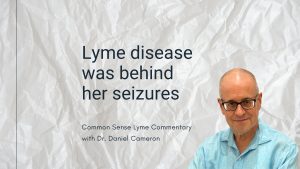Call for your appointment today 914-666-4665 | Mt. Kisco, New York

“A 58-year-old woman was seen in the outpatient neurology clinic of this hospital in early autumn because of hypoesthesia [numbness], paresthesia, and weakness,” writes Reda and colleagues in a paper describing atypical symptoms of Lyme disease.
Her initial symptoms began 10 weeks prior with back pain occurring between her shoulders. But the pain resolved without intervention.
Several weeks later, numbness developed in a bandlike distribution around her trunk, writes Reda from Massachusetts General Hospital and Harvard Medical School. The following week, the numbness spread, extending to her upper abdomen.
“The patient was unable to sit up from the supine position without using her arms, and she had abdominal distention,” explains Reda.
Her symptoms progressed. Paresthesia (tingling or burning sensation) developed in the third, fourth, and fifth fingers of her left hand and the fourth and fifth fingers of her right hand.
The numbness that she was experiencing extended to the genital area, causing urinary incontinence.
The woman, who lived in a wooded area of Connecticut, reported having a “small, uniformly erythematous, painless, nonpruritic rash that was consistent with the hallmark skin lesion of early Lyme disease, erythema migrans,” the authors explain.
She believed the rash, which occurred three months prior to her admittance to the hospital, was caused by an insect bite. It resolved without treatment.
Her medical history also showed hypertension, hypothyroidism, and left tibial and fibular fractures resulting from a fall, along with L4 – L5 decompression and bilateral medial facetectomy.
She also presented with diabetes with a blood glucose level of 291 mg per deciliter and a glycated hemoglobin level of 11.8% (normal less than 5.7).
There were no other identifiable causes for her symptoms, despite having an extensive evaluation.
“Her recent rash and associated risk factors for Lyme disease made Lyme radiculopathy our leading diagnosis,” the authors write.
A Lyme disease Western blot test revealed 9 out of 10 IgG bands were positive.
The woman did not need a spinal tap to confirm her Lyme disease diagnosis because, as Reda explains, “When a patient is seropositive and has a characteristic clinical syndrome for Lyme neuroborreliosis, as in this case, CSF tests for Lyme disease are unnecessary to establish a diagnosis.”
Nevertheless, a spinal tap was performed. “Direct detection of the infectious agent with CSF PCR assays is usually not possible,” the authors explain.
“CSF PCR assays for Lyme-related Borrelia are not recommended,” they state, “and a negative assay (which was present in this case) does not influence diagnostic considerations, because sensitivity of the assay is poor.”
Final diagnosis
“On the basis of the patient’s clinical features and seroreactivity, the final diagnosis was Lyme meningoradiculitis,” writes Reda.
The patient improved with a 3-week course of intravenous ceftriaxone. Although her pain diminished over the next 4 weeks, she continued to have some residual problems.
Four months after her initial treatment began, “her sensation and strength of the abdominal wall had increased such that she could contract the rectus abdominis muscles while standing,” Reda explains. “But she continued to have difficulty sitting up from the supine position.”
“The weakness of the left foot had diminished, but she still had difficulty walking on the heel,” writes Reda.
Editor’s note: It is fortunate that the doctors recognized the atypical symptoms of Lyme disease. The authors did not discuss the concerns some doctors have raised regarding a persistent infection. (There is no reliable test to rule out a persistent infection.)
Related Articles:
Neurologic Lyme disease presenting as abdominal pain in 71-year-old patient
Atypical findings in Lyme disease make diagnosing difficult
Case demonstrates importance of follow-up with Lyme disease patients
References:
- Reda HM, Harvey HB, Venna N, Branda JA. Case 34-2018: A 58-Year-Old Woman with Paresthesia and Weakness of the Left Foot and Abdominal Wall. N Engl J Med. 2018;379(19):1862-1868.




I experienced this for 3 weeks about 2 yrs ago. It felt like novacane on entire right lower quadrant down to right hip. It makes me sad to this day local Drs treat lyme patients so poorly. After a decade of lyme/babesia and co many of us cant afford to see lyme specialists any longer. I really wish there was some way to educate mainstream about things like this illness. Being treated poorly on top of this illness feels like a slap in the face. The mental abuse we go through from mainstream medical is the worst part of this illness. Very sad
I was diagnosed with Lyme myositis 7 years ago by a neurologist. One of the test she ordered was a muscle biopsy. The tissue samples were sent to a lab that never examined muscle biopsy tissue samples for evidence of borrelia burgdorferi and my patient history did not go along with the samples. The lab did not examine them for borrelia. Instead they wrote a separate report with this sentence: This suggests a possibility of polymyositis. I was sent to Rheumatology next. There I was given immunosuppressants:prednisone and others. After a few months of no improvement I was told by the rheumatologist that Lyme disease does not exist in our state and that I had polymyositis. He changed the diagnosis without any further testing to polymyositis. After over a year with worsening symptoms, he left me with these words: You have a serious condition but I cannot help you I’m sending you to the university where the lab is located( on the far other side of our state).
I also see complicated cases. I refer my complicated cases to rheumatology as needed for them to weigh in on the case. I try not to dismiss Lyme disease so readily. I would advise my patients to look a second time at Lyme disease while asking a second rheumatologist to weigh in. BTW there is Lyme disease in Wisconsin as you already know. Call my office at 914 666 4665 if you have any questions.
I am having traveling, Burning, radiating nerve pain, And tingling and brain fog. I had fatigue symptoms four years ago and tested positive for Erlichiosis and anaplasmosis however it was “borderline” so they would not treat me.
I went to the E.R. two years ago and again tested “borderline”. I asked the e.r. Doctor to prescribe doxycycline. He did and I felt so much better within days and like a new person three weeks later… until 6 weeks ago. Went in to see infectious disease specialist, who ordered a full tick panel. All other diseases were negative and Lyme came back “low” ( .91 I think). I was not treated. He wants me to repeat the test now. Also saw neurologist who ordered more blood work. An ANA test came back “slightly elevated” indicating RA or Lupus. Following up with neurologist next Tuesday. Hope he listens. Symptoms are uncomfortable.
I have patients that have gone down that path. Most doctors I have seen exhaustively look follow every lead but are reluctant to look at Lyme disease again unless the tests are positive.
My daughter was healthy and energetic. She was bitten by a tick twice and both times I was refused doxy. Her only symptom was long standing slight swelling of the lymph nodes near the bite (back of neck) now she is usually tired a lot, has very poor posture and can only eat very small meals and never breakfast. Sensitive to load noises and light. Some anxiety and depression with zero stress tolerance. I ordered blood tests and her CBC shows Low RDW and high triglycerides. Normal folate and B12. Low vitamin D. Elevated kryptopyrrole urine test at 36+ which may be an inherited condition. Any suggestions? It’s been a few years. Thank you.
I find that individuals with Lyme disease in my practice typically have a broad range of other symptoms that help make the diagnosis. Your daughter appears to have other findings that might be helpful in making a diagnosis. I advise my patients to include an evaluation by a doctor experienced in treating Lyme disease in addition to other doctors.
Just Diagnosed with Lyme after 5 years of being told I have MS by 5 doctors (2 of them being “MS specialists”). I can’t feel my skin from bra down. Feet feel like I have duct tape on the bottom and tingling and walking on nails feeling all at the same time. I’m about to start treatment with BB-1 but terrified that this horrible flare isn’t a flare but is permanent. What else can be done to stop the flare? – taking turmeric, E, D, aloe Vera, B6, B12, folate, and C’s. Also currently on a nasal spray for strep and a binder.
Lyme disease and multiple sclerosis can look alike. I often find antibiotics helpful in my patients even if they have been ill for 5 years. You did not mention whether you tried antibiotics.
I’ ve been having constant muscle twitching that comes and goes all over for 8 years now. On top of that i also have back pain for 9 years. I was diagnosed with hernia and spinal stenosis. I also have intermminent aches and weird sensation in legs for years now. For the last 5 months i have patella clicking, nerve pain in the sole of one foot and slight paraesthesias in the same foot. I was diagnozed for tarsal tunnel syndrome but this doesn’t explain the tingling in legs and constant muscle twitching for years. Could it be Lyme desease? Ι live in Greece? Where could i get tested and treatment? Is Western blot test relaible as a first step? Thank you in advance!
I would typically include a doctor with expertise in Lyme disease. I would also keep working with other specialists for other illnesses. I have had patients who have more than one illness. I do not know enough about the region to help you.
Daughter permanently disabled [ 21 years from age 7 and still infected ] and looking as though son will be also. [ 20 years from age 5 ] Husband – almost died, but the doctor called him a Lyme lunatic. Me – I almost didn’t make it either. 250,00.00 given to the the medical ‘industry ‘ and counting.
My father started experiencing foot numbness and severe fatigue that no one could explain. He received the covid vaccine and the numbness moved into his legs, saddle and trunk region, and now to his hands. Severe calf cramping and he can barely walk. Pushed for a Lyme test which was positive active infection. 21 days of doxy. Question I have is will the numbness stop progressing and is this a typical presentation? Could the calf pain be bartonella? I plan on pushing for IV antibiotics
It sounds as if a tick-borne illness has not been adequately addressed. You might find working with a doctor experienced in treating chronic manifestations of Lyme disease.
I’ve read that the majority of Morgellons sufferers test positive for Lyme disease. Are you familiar with this? And will treatment for Lyme disease lesson the symptoms of this mysterious, unbelievable disease that only a hand full of doctors will acknowledge while the remainder of them including the CDC say it’s a mental illness and those who suffer from this horrific disease are delusional as the number of patients steadily increase all over the world except for island. Suggesting all of these patients from everywhere all over the world are some how imaging all of the same unimaginable things while suicides are prevalent and lives are consumed. A lot of which have been committed to mental hospitals or referred to psychiatrists for delusions and psychosis. While each patient either has or or will lose the quality of their life. Through isolation, loss of jobs, no infer able to work bc the disease is all consuming. It’s very common for some or all family members and friends not believing you bc a lot of it isn’t possible or has never happened to a human. Yet as alone, terrified and abandoned as they are desperately seeking help when they’re dismissed as crazy and delusional needing help in support ever, yfriends and health professionals
OR…IT HAS NEVER HAPPENED TO THEM PERSONALLY. Meaning..unless it directly affects them…most people do not care. If they’ve been vaccinated… unfortunately they will find out sooner than later
Chronic Lyme, Bart, Babesia and other coinfections, finally diagnosed after getting no where and have probably had this since my teens, just turned 60. Is there any correlation with bartonella and recurrent inguinal hernias? I’ve had 2 repairs on my right side and now seems I have 1 on the left side?
I have not seen any correlation with a tick borne illnesses and inguinal hernias. I have seen patients in my practice who realize they have Lyme disease while being evaluated for another illness.
I had burning shoulders…especially around the shoulder area where I had the vaccine booster. Also a badly swollen knee, where I had reconstructive ACL surgery 20 years ago. I went to one of the leading university hospitals in the country and was diagnosed by a Rheumatologist with a garbage label of RA. More respectively, Inflammatory Arthritis with a form of Myalgia. This diagnosis was given to me before they ordered 12 vials of blood. A huge red flag, in my book. I was prescribed a lifelong treatment of a low dose chemo for the rest of my life. The side effects alone can be fatal and might be worse than the illness. Flash forward 6 weeks later to today: I got in with an infectious disease doctor who is an out of the box thinker. He looked at my knee and he wanted to know when I got bit by a tick. He also looked at all 5 version of unremarkable blood work that was taken by prior Rheumatologists and two things stuck out: elevated ANA count (which often gets confused with Lupus, RA or Hoshimotos). Infectious disease doctor ordered a proper Lyme test with Western Blot and ELISA and several bands came back for borrelia burgdefori but the CDC would not approve a positive result for Lyme. Only some markers for Lyme and test result as Indeterminate. What does that even mean!? There is hope: I am three weeks of doxycycline and the knee swelling and pain improved 4 days later. I still have several months left of antibiotics. Best advice is what some of the Doctors on this thread recommended: find an infectious disease doctor (Lyme specialist) or better yet: functional medicine to get to the why or cause before you make a garbage diagnosis that can ruin your life. Hope this helps.
My mom has had Lyme disease for about 2 years and experiences paresthesia everywhere with some days having it more than others but it never goes away. She’s been on treatment and has 2 more weeks to go because they found she also had brucellosis and bartonella. She’s done lab test and they show she doesn’t have damage in her nerves. My question is, is this permanent or will it go away once she finishes her treatment?
Lyme steals a life long before it ends it.